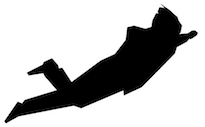Obs
Sam Skinner
ISBN: 978-3-943196-77-1 // 168 pages // 97 x 138 mm // Soft-bound sewn binding with dustjacket // Set in Grotesque and BB-Book // 3 colour risograph printed by Footprint Workers Co-op on Munken Lynx // RRP £15 // Edition 200 // Designed by Mark Simmonds
A Broken Dimanche Press Publication // Berlin, 2019 // www.brokendimanche.eu
In a world awash with instruments and data, a local reading group devise to build an observatory, as an act of resistance against their own observation. What follows is a story that collides measurement and experimentation, with language and the senses, both human and non, conjuring a playful satire of our contemporary technologically meditated condition.
Through a lively interplay of oddball fictional narrative and risograph printed imagery, Obs asks: How did the strange and peculiar functions of the observatory and observational science, once specialised institutions and practices, become such a part of everyday life? Has the whole world become an observatory, or rather have we become observatories of ourselves? And what might an alternative observatory be, one run by amateurs, artists, and the observed?
Obs is the curious product, of both artistic and curatorial research, concerning the observatory. In 2017 Skinner co-curated The New Observatory exhibition at FACT, Liverpool, alongside PhD research into the history and contemporary status of the observatory. Obs emerged between the cracks and fissures of these activities, and functions as a para or meta text to these bodies of research. Obs is also a personal work that channels the author’s everyday experience of surveillance and being observed, into text and imagery that embody and ruminate on possible modes of resistance and obfuscation.
Across Obs pages, the observatory functions as a unique touchstone to explore our contemporary relationship to data and evidence. The book’s text and imagery reflect upon the observatory’s history as one of continual change and proliferation, evolving from stone circles to networks of satellites in space, instruments at sea, and the devices in our pockets.
At the core of the book is a concern with how the observatory evolves and reproduces itself, and our enmeshment with it. As the convergence of public and private life with observational science and technology continues to grow, Obs speculates on a future or alternate role for the observatory.
Through its characterisations and narrative mood, Obs appropriates and contorts the rhetorical tones and protagonists of observational technoscience, from bombastic instrument makers of the 19th century to today’s exultant data evangelists. The book sets these observers in dialogue with the observed; an unassuming, if no less inventive, local reading group. Equally, the imagery within the book détournes the graphical techniques and inscriptions of observational science, from graphs to diagrams, redeploying them as artistic illustration or remixed with Skinner’s own drawings. Whilst, the compact form of the book links to the bibliographic devices of science, such as notebooks and almanacs. Thus emerges within the book an encounter between art and science via the fulcrum of the observatory. In which observation is exposed as a key bridge between the ‘two cultures’, with uniquely shared textual, visual, instrumental, and social practices. But which also clash in confrontations between propositional and reproducible knowledge on the one hand, and the improvisational and poetic on the other.
Philosophically the book engages with post-human and new materialist turns in the humanities. It is of note that the author was engaged as co-editor of the New Materialism Almanac (www.newmaterialism.eu) a glossary of philosophical terms, during the writing of Obs, and this is linked to within the text. Accordingly, Obs is influenced by concepts such ‘natureculture’, which add complexity to the relations between the biological and the technical, and alternative literary theories which re-think processes of reading and writing in ‘more-than-human’ terms.
As an artist book, Obs is an uncommon artefact of hybridised processes of, and encounters between, the humanities and the sciences, the curatorial and the artistic. Furthermore, its pocket-book size and quixotic imagery and text, that the author describes as being like a ‘children’s book for adults’ will produce its own unique encounters with readers. Accordingly, and at its heart, Obs is playful work that seeks to re-inscribe a little of the noise and ungraspable excess that is excluded in acts of observation, back into the world.


